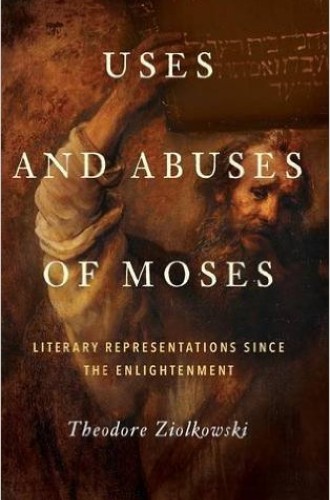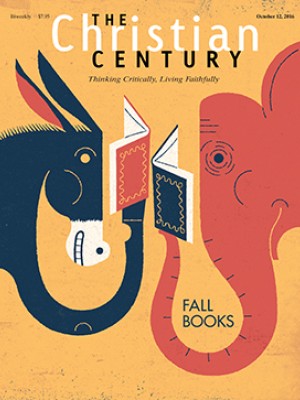Multitudes of Moseses
From baby in a basket to liberating lawgiver, Moses has been all things to all people.
A great deal has changed in scripture interpretation since the high days of modernism. Interpreters no longer seek original intent of the text in the fashion of the late Supreme Court justice Antonin Scalia and as was demanded by historical criticism. Readers of scripture are no longer preoccupied with the author or the original context. Moreover, readers are aware that the biblical text cannot be corralled to serve any particular orthodoxy, which always required a somewhat skewed reading. Now scripture reading thrives on the generative force of imaginative interpretation. The outcome of such work is the recognition that interpretation (and the meaning and work) of the text is pluralistic, complex, and most likely not disinterested.
Theodore Ziolkowski, who taught German and literature at Princeton University, has written a history of interpretation of the Moses tradition. His subtitle indicates two ways in which he has limited his scope: he is concerned with interpretation in the modern period, and his focus is on “literary representations.” The latter means that his interest is in renderings of the text in novels, drama, music, and visual arts. While there are implicit political dimensions to this book, it would be well read alongside Bruce Feiler’s America’s Prophet: How the Story of Moses Shaped America, which focuses on political discourse.
Read our latest issue or browse back issues.
Ziolkowski explores the immense latitude that interpreters of the Moses tradition have taken in rendering the material useful for them. He find there are “three pronouncedly ideological uses of Moses”:
by Hitler in his anti-Semitic rants against the Jews, by the Holocaust survivor Wiesel as a model for the will of the Jewish people to survive precisely the genocidal efforts of people like Hitler, and by Churchill as the exemplary leader for all men in an age threatened by destruction.
This modern practice is not discontinuous from the older rabbinic tradition of interpretation that found the biblical text immensely plastic, open to rich alternative meaning that smacks of acute ideological interest. This rich interpretive tradition was not preoccupied with “historical questions” as was required by modernist rationality.
In the 19th century there is wide appeal to “Egyptomania,” based on critical study but given dramatic and artistic expression in ways that attest Moses’ capacity for forceful and violent strength. Ziolkowski highlights here the poetry of Victor Hugo and the work of Chateaubriand, Rossini, and Heinrich Heine. Heine sees Moses as an early moralist. A novel by Joseph Holt Ingraham in 1859 is judged to be the antecedent of Cecil B. DeMille’s later blockbuster.
Ziolkowski gives special attention to the use of the Moses tradition as a tale of liberation. He cites Frances Harper who had appealed to Harriet Tubman, followed by reference to the contribution of George Eliot and a suggestion that Twain’s Huck Finn is a reconstruction of the Moses saga. Arnold Schoenberg’s later work is also linked to Moses, as he moved into a passionate Zionism that could recruit Moses for support and legitimation. This connection of Moses to Zionism is reinforced by Theodor Herzl, who carried his passion for Zionism in a practical and effective direction.
In the 20th century Rilke offers “The Death of Moses.” Jewish interpreters after World War I provide a humanized Moses but also an anti-Zionist version of his story. In the mid-20th century Moses is intensely politicized, rendered both as eagerly Zionist and as anti-Zionist, reflected in the rise of fascism. Ziolkowski highlights three alternative readings from the 1940s: Freud’s fantasy interpretation, Zora Neale Hurston’s reading in an African-American dialect, and the script of DeMille with “a strongly Christian orientation.” Before he concludes, Ziolkowski also offers “a Mormon Moses” and brings matters up to date with the traumatized reading by Anthony Burgess and the 2012 work The Lawgiver, by Herman Wouk.
Ziolkowski has no great theory about his history of interpretation beyond notice of its vast pluralism grounded in the fact that the text itself is indeterminate and subject to almost limitless imposition by interpreters. Such an exhibit yields the awareness that “there is no answer in the back of the book.” Hard-won absolutism is possible only within an isolated reading community that reads according to its own ideology, without disruption by other lively realities. There are, of course, many such isolated reading communities (academic and ecclesial), where playful artistry appropriate to the text—so much on display in Ziolkowski’s interpretive history—is woefully lacking.
In the rich variety of readings Ziolkowski reviews, he sees three major themes—Moses as “leader and liberator of his people, lawgiver, and prophet of a monotheistic deity”—recurring across the literature. Ziolkowski does not do much with what might be made of such reception. This book might be followed up by a sustained reflection on what is now termed reception history, in which the sum of all of these readings together constitute the meaning and work of the text.
We are of course free to choose a single reading as “the right one,” but a wiser course is to take all of these readings into consideration. In that way, we recognize that we are before a text that refuses to be reduced to our rendering of it. We are thereby invited to modesty. But we are also invited to continue the bold interpretative tradition—all the while knowing that our reading is not a “final reading.” As we do so, we will inevitably bend the text toward our context and interest. Ziolkowski’s study invites us to the awareness that we ourselves, in our own interpretive work, continue bold readings of the text with the permit given by our predecessors in the urgent duty of interpretation.







